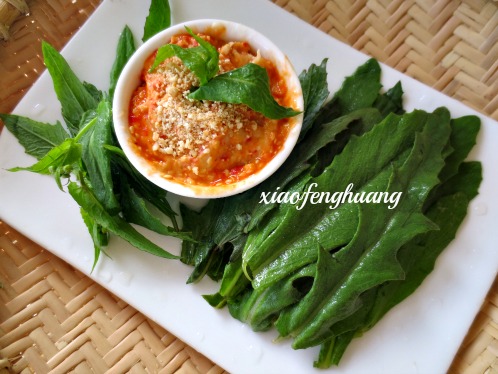The first one is the Ironweed aka Kechondong ari (Iban) aka Tambak bukit (Malay) which is actually a Chinese herb for ages, more popular among the Hakka people. Its Hakka name is Xiao shan hu (消山虎). Its ID is Vernonia Cinerea (Linn.)Less. It is included here because its has flowers that look very much like the other three edible weeds.

Its has tiny purple flowers with diameter 2-3mm and the plant is very slender with height 20-80 cm. The leaves are very tiny too. In Chinese medicine, it is used for cough caused by colds or flu. Infusion of the dry/fresh plant without the flowerheads is taken for cough caused by colds and flu. Triterpenes are the major constituent of the herb which give the herb its therapeutic properties. It is difficult to grow and usually can be found growing wild in open space.
In Thailand, it has been used to relieve cigarette craving. Ironweed infusion does not taste bitter. In fact, it does not taste like medicine. Hakka people believe that it can be taken regularly owing to its ability to get rid of ‘wind’ from our body system.

The next on the list is the American burnweed/ fireweed . Its ID is Erechtites hieracifolia (L)Raf.ex DC.It is also known as Sintrong (Sunda) , Sawi Rusa (Iban) and Jebung (Bidayuh). In Chinese is 昭和草 which is very popular in Taiwan and Japan. It has a kind of mint taste.

Its has inflorescence terminal bearing pinkish red flowerheads with diameter 6-7 mm. Its leaves are broad lance-shaped with irregularly toothed margins. Its flowers and leaves are edible. Very often flowers are collected and deep-fried or pan-fried with batter or simply fry with eggs. The leaves smell like mint and best eaten raw with tempoyak and grated nuts.

The picture below shows Sawei/Sipiyuon aka Tropical burnweed which is very popular among the land dayak as wild vegetable. Like sintrong, it has inflorescence terminal bearing flowerheads of same size and shape but the colour is more orange red. Its leaves are oblong lance – shaped and deeply lobed. Its ID is Erechtites valerianifolia (Link ex Spreng) DC. as identified by our research officers at the Research Center of Semongok.

An interesting feature of this wild vegetable is it tastes very similar to ‘Tang Oh’ from China. Tang Oh from China is Chrysanthemum coronarium L. Wild ‘Tang Oh’ plants sprout from the hill padi field shortly after the land is burnt and if heavy rain follows, the whole area will be full of the young plants. The taste is exactly like the cultivated one except that it has stronger fragrance and the leaves are more crunchy. These two features make it great for steam boat or any soup which needs extra flavor. Blanch the leaf and add thick soya sauce, brown sugar, lime juice, olive oil and chilli powder. Yummy, yummy, yummy……….

The flowers are cooked in the same way as the sintrong. Though Sintrong always grow wild side by side with Sawei, they taste quite different. Sawei leaves are soft and taste good in soup. Its leaves can be eaten raw too, like the sintrong leaves. Both sintrong and sawei are difficult to grow in urban area. However, they thrive very well in hill padi fields.

The picture above shows sayur jonghe(Sundan), aka Setumbak Merah(Malay), Ensabi Bukit (Iban), Cupid’s shaving brush and its Chinese name is 一点红. It grows wild but can be grown easily in pots. All three of these weeds, jonghe, sintrong and Sawei are popular in Indonesia as well. Its ID is Emilia sonchifolia L. The shape of its flowers look like sintrong and sawei flowers but the colour is purplish pink. The lower leaves are heart-shaped and the upper leaves linear with tooth margins with base expanded clasping the stem. Flowers can be collected and deep fried or pan-fried with batter .
All three of these weeds have tiny seeds dispersed by wind and leaves that can be eaten raw. Sintrong tastes better when eaten raw. Sawei has good flavour and tastes good both in soup or eaten raw. As for Jonghe leaves, only the young ones can be used.

About tempoyak, please click here.
About the nutritional value of Sawi rusa, please click here.
Be proud of our rainforest. It provides us with a huge diversity of wild edibles including the wild ferns and herbaceous plants that can be used as herbs and vegetables as well, not to mention all the wild fruits and rare nuts.
Love nature,
Love our rain forest,
Love our mother earth.
Copyright claim – Do not crop any pictures from malaysiavegetarianfood.com.Do not share our pictures without any watermarked signature on them.Excerpts from our articles to be credited to malaysiavegetarianfood.com.

